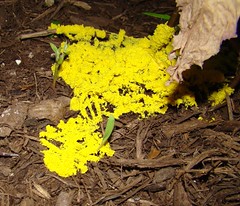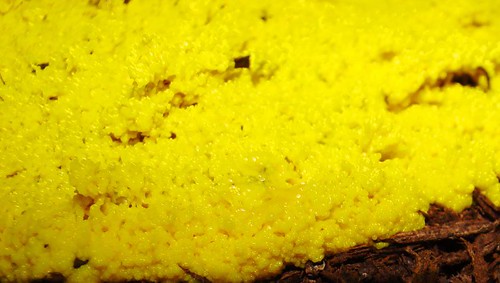I glance out the front window a few minutes ago and saw a bright yellow splash in the flower bed. Did the girls spill paint out there?
My heart did a dance when I went out and got a closer look....
SLIME MOLD!!! My first slime mold!!!!

Two huge swaths of it, growing under my Little Blue Stem and also under my Shadblow Serviceberry bush. (Native plants...ahem.)
I probably should have waited until morning, to get pictures of it in the sun, but I was too excited and had to share....it is a surreal shade of yellow. Not butter-yellow. Or even canary-yellow.
It's freakin' CRAYOLA yellow.

I have read about slime molds. The book that comes to mind immediately is Bill Bryson's A Short History of Nearly Everything. Bill Bryson is a travel writer, but also does fantastically droll and pee-in-your-pants hilarious works on other topics, too. Get some of his books. You will be glad you did.
Slime molds:
The term "slime mold" is a broad term describing 'fungi-like' organisms, that use spores to reproduce. Called slime mold because of one of their life cycles is decidedly gelatinous. They feed on bacteria that grows on dead plant matter.
This particular flavor of slime mold I encountered is a common one, Physarum polycephalum.
It has a phase of development called the "streaming" phase...when it sends out thin strings of itself, surrounding its food and sending out enzymes to devour it. They do this by rhythmically contracting its protoplasm to allow itself to move.
And get this...those people who get to say where something goes in the biological order of things? They can't decide if it is an animal or plant!!!
From an article about some scientists who put this slime mold into a maze:
"A team of Japanese and Hungarian researchers, writing in the journal Nature, claimed to have found the slime mold Physarum polycephalum is capable of finding the shortest way through a maze. Pieces of the slime mold were enticed through a 30-square-centimeter (five-square-inch) maze by the prospect of food at the end of the puzzle. The researchers concluded that the creature was exhibiting a kind of primitive intelligence.
Normally, the slime spreads out its network of tube-like legs, or pseudopodia, to fill all the available space. But when two pieces of food were placed at separate exit points in the labyrinth, the organism squeezed its entire body between the two nutrients. It adopted the shortest possible route, effectively solving the puzzle."
They also seem to be able to anticipate events:
"As the cells crawled across an agar plate, the researchers subjected them to cold, dry conditions for the first 10 minutes of every hour. During these cool spells, the cells slowed down their motion. After three cold snaps the scientists stopped changing the temperature and humidity and watched to see whether the amoebas had learned the pattern. Indeed, many of the cells throttled back right on the hour in anticipation of another bout of cold weather. When conditions stayed stable for a while, the slime-mold amoebas gave up on their hourly braking, but when another single jolt of cold was applied, they resumed the behavior and correctly recalled the 60-minute interval. The amoebas were also able to respond to other intervals, ranging from 30 to 90 minutes."
If that's not cool, I don't know what is. Pretty damn smart for a single-celled organism.
This stuff doesn't feel like a dry foamy sponge, like a fungus would. It's wet and fluffy, like perfectly-cooked scrambled eggs.
Great. Now I'm craving eggs.

This unique thing of beauty is growing right outside my front door.
Lorelei wants to know if there is a Life Slime Mold Dance?

10 comments:
Wow! I've never heard of slime mold but it sounds pretty wild. Must be neat to get some in your own garden. I think this would be an appropriate life slime mold dance but hard to do if you're not a cat: http://www.youtube.com/watch?v=gD_yb0dgIT8
Yowza! That has got to be the most amazing thing I have read in a loooooong time, Susan! Were you anticipating slime mold?
I have seen mold in different colors from this but nothing this neat.
I also saw following a tree root, a series of perfectly round balls. Closest to the tree were the largest basketball size balls and closest to the end of the root were the smallest golf ball size mushrooms or fungi -- maybe puffballs but these were perfectly round with a stem.
Freakin' awesome Susan!!! I want some, too! Once you make up the dance, video it for us so we can see what to do when we come across some!!
The question now is, what will it do to your garden? You could make a movie, "The Slime that Ate Cincinnati"!!!
Cool. I had lots of it in Maryland. I didn't know what it was called. I remember after it was old, it seemed to blow smoke from underneath when I jabbed it with a stick. Red smoke.
ohhh...I love fungus, molds..and all those growths that love dark and moisture..
This one is quite lovely and bright and saffron rice looking..
What a lucky find, that slime mold is gorgeous. Isn't Mother Nature grand? Seeing this makes me wonder if you've answered a question I've had for sometime. Will slime mold grow on other fungi like ink cap mushrooms? A couple years ago I found several ink cap mushrooms covered in a slimey bright yellow filmy substance. It was unique, beautiful and puzzling. I too think Bill Bryson is a wonderful writer, I've read several of his books.
Several years ago we had our yard landscaped and wood mulch spread between the stepping stones. then came back two weeks later and found big yellow blobs all along the path. YOWSAH! Not what we paid the big bucks for! This the NC coast, so I guess it has no boundaries, huh?
sửa chữa nhà phố cổ
sửa chữa nhà trọn gói
báo giá sửa chữa nhà
Post a Comment